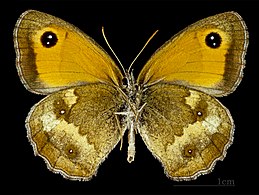| Gatekeeper | |
|---|---|
| Male | |
 | |
| Both in Oxfordshire, England | |
| Scientific classification | |
| Domain: | Eukaryota |
| Kingdom: | Animalia |
| Phylum: | Arthropoda |
| Class: | Insecta |
| Order: | Lepidoptera |
| Family: | Nymphalidae |
| Genus: | Pyronia |
| Species: | P. tithonus |
| Binomial name | |
| Pyronia tithonus | |
The gatekeeper or hedge brown (Pyronia tithonus) is a species of butterfly found across Europe. [1] Given its preference for warmer weather, the restriction of range expansion can be assumed to be due to climate.[ clarification needed ] Colonies vary in size depending on the available habitat, and can range from a few dozen to several thousand butterflies. [2] Named for its rigorous patrol of hedges and woodland rides, the gatekeeper butterfly is a prime pollinator. [3] The caterpillars primarily feed on fine grasses such as fescues (Festuca) and bents (Agrostis), which are common in meadows and roadside verges. [4]










